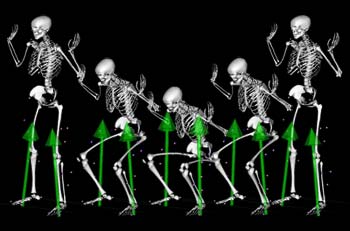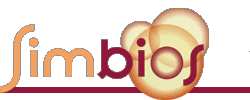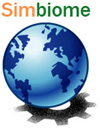BY JESSE GARNIER
Three Florida middle schoolers have blasted into the scientific stratosphere after their science fair project on microgravity was accepted for presentation at the 2012 American Society of Mechanical Engineers (ASME) Summer Bioengineering Conference in Puerto Rico.

Eighth graders Christopher Fregly, Brandon Kim and Zhao Li used the OpenSim biomechanics simulation software to determine the muscle and shoulder loads for a squat exercise performed on the International Space Station, Mars and the Moon. Green arrows indicate ground reaction forces as measured on Earth.
|
Gainesville eighth graders Christopher Fregly, Brandon Kim and Zhao Li used the OpenSim biomechanics software developed at Stanford to estimate the effects of microgravity on exercising astronauts in outer space, on the moon, and on Mars.
Gravity on Mars is about 40 percent of Earth's, and the moon's gravity is about half that of Mars. Without vigorous exercise, astronauts' muscles weaken in space where they are not forced to constantly work against Earth's gravity.
"Astronauts lose muscle mass in space so they need to use exercise machines to keep their muscles strong," Christopher said. The 14-year-old was inspired after a family trip to Houston that included a visit to NASA's Johnson Space Center.
The students wanted to find out how microgravity would affect muscle loads for current and future space travelers. So they cooked up a series of computational experiments with the assistance of Christopher's dad, B.J. Fregly, associate professor of mechanical and aerospace engineering at the University of Florida, and John De Witt, senior biomechanist with Wyle Science, Technology and Engineering Group and a NASA contractor.
The elder Fregly introduced the boys to OpenSim, a software package used to simulate forces and loads within the human body. OpenSim was developed by Scott Delp, professor of mechanical engineering at Stanford University, and his team in collaboration with Simbios, the NIH Center for Physics-based Simulation of Biological Structures at Stanford University.
De Witt provided them with existing NASA data from ground-based exercise research.
From there, the intrepid teens took things to the next level. But it wasn't easy.
"We put in a lot of work, about 70 hours," Zhao said. "Over Thanksgiving, we worked six hours a day."
The students fed the NASA data into OpenSim, then adjusted the gravitational force within the program to simulate results on the moon and on Mars, as well as in orbit. Their analysis showed that no amount of force could be added at the shoulders during a squat exercise in microgravity that would simultaneously provide the the same loading of the hip, back, and leg muscles as experienced in normal gravity.
Currently, astronauts compensate for the loss of body weight during squat exercises by adding about 70 percent of their body weight to the bar. Simulation work by De Witt confirms this is sufficient to recreate joint loads at the hips that would occur under the Earth's gravity. But the boys' project extended the analysis to show it wouldn't be enough of a workout for the leg muscles on Mars or the moon.
"We learned exactly how much muscle load each joint was getting," Brandon explained. "Ankles and knees were underloaded in space compared to earth." So the boys suggested adding bungee cords to the pelvis to help distribute some of the load from the shoulders to the lower joints.
Their project was good enough to win "Best in Show" in their regional science fair and earn them a spot in the statewide competition.
At the statewide science fair, the boys started to get excited as the winners were announced. "Chris did a fist pump every time we didn't get called," Zhao said, "saying 'at least we got fourth (place), at least we got third.'"
When the second-place winner in the health and medicine category was announced, they heard familiar names: their own.
The success didn't stop there, either.
The boys' winning six-foot wide science fair poster was distilled into a two-page paper that was accepted for a podium presentation at the ASME Summer Bioengineering Conference. NASA contractor De Witt praised the paper as a valuable contribution to the scientific body of knowledge:
"The science was very good. Really no different from what we do here or what professionals are doing with OpenSim.
"99 percent of my work has been in zero gravity," explained De Witt. "We haven't explored loads under lunar or Mars gravity — yet. That's what the kids have brought to the table."
OpenSim is freely available software that has been used by thousands of researchers, clinicians, and students to model and simulate human and animal movement. More information on OpenSim is available at
http://opensim.stanford.edu.
Simbios provides infrastructure, software, and training to help biomedical researchers understand biological form and function as they use computer simulations to create novel drugs, synthetic tissues, medical devices, and surgical interventions. More information on Simbios is available at
http://simbios.stanford.edu.
|





